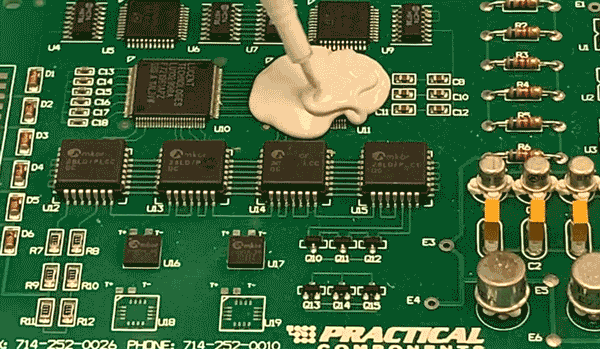
Thermally conductive polymers are adhesives, coatings, and films designed to transfer and conduct heat out and away from sensitive electronics. They protect sensitive components (such as integrated circuits) and can substantially improve product durability while reducing field failure rates.
In previous discussions, we addressed the choice of material and application methods. That said, extensive experience in real-world situations has illuminated often overlooked properties that can be of great importance:
Viscosity and Flow Rate
There are numerous standard considerations when deciding upon a thermally conductive potting or encapsulation compound, including:
- Material Considerations
- Thermal Conductivity Level (Low/Med/High)
- 1 or 2 Component
- Chemistry (Epoxy, Urethane, Silicone…)
- Hardness
- Exothermic Properties
- Chemical or Environmental Durability
- Regulatory Issues (UL, ROHS…)
- Processing Considerations
- Speed of Cure
- “Open” or Workability Time
- Equipment Required
- Viscosity/Flow Characteristics
Here, we will delve a little deeper into flow. Experience has shown it receives inadequate attention in the design process.

Why Viscosity Helps PCB Protection
OK, so what is the big deal about flow and viscosity? Why not just go with the highest number for thermal conductivity and be done with it?
Simply put, the reason has a lot to do with getting the highest performance out of your thermally conductive polymers. The stated characteristics, most importantly thermal conductivity, are based on testing done under ideal conditions in a laboratory environment by the supplier. As you might imagine, “actual results may vary” is very applicable here and product performance in real-world situations can fall well short of technical data sheet numbers.
Related Article: How to Improve the Flow Rate of Your Encapsulating Fluid
There are reasons for this potential shortfall which can include:
- Inadequate mixing before or during use
- Inconsistent filler content
- Excess oils or surfactants on the surface
- Inconsistent self-leveling
- Entrapped air or outgassing components
Thermally conductive polymers are almost always HIGHLY LOADED with heavy and dense (often) metal-based fillers. Most of the pitfalls involved in working with them are related to this high filler content that is prone to settling. Low viscosity, as well as excellent flow characteristics, are significant advantages in facilitating mixing, consistent filler and plasticizer dispersion, and quick self-leveling.
Resin Designs Thermosink 35-7
Chase Corporation through our Resin Designs division has extensive experience in the design and manufacture of thermally conductive polymers through our THERMOSINK range. Thermosink 35-7 specifically has been designed for low viscosity, and superior flow performance making it suitable for higher-speed processing. Thermosink 35-7 key advantages include:
- Mixed viscosity < 10K CPS
- Unique filler size and geometry
- Superior flow and self-leveling properties
- Less prone to bubble entrapment
- Capable of high-speed processing
Chase Corporation, through our Resin Designs division, has designed a full range of Thermosink brand polymers with a range of hardness values, viscosities, and cure times. As a supplier of electronics protection polymers and coatings, Chase Corporation and its employees can help you with an unbiased approach to evaluating your application and process. We’ll show you how to maximize efficiency, minimize cost, and improve product reliability. Our outstanding manufacturing and technical support groups can provide your organization with reliable global supply, unmatched quality, and superior technical support.
Please contact us today to discuss your application.







